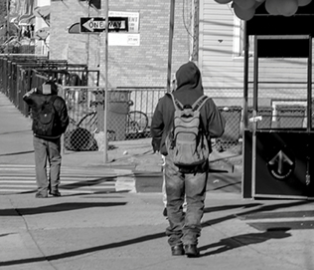Combing the streets of New York City, I found myself practicing my ethnographic approaches. I stepped into local business and places where people conjugated. I went in during strategic times and spoke to people about nothing in particular. Just made a point to get to know people and empathize with their everyday New York journey. In turn, I also attended events connected to my interests of intersections concerning technology, human welfare, civil rights, and immigration advocacy.
After weeks of exploration, on a humid summer morning, I noticed a group of men standing at a street intersection in Woodside, Queens, NY. Public transportation would make the local stop, and none of the men would take it. The group of men continued to wait. From afar I observed their wait with curiosity. I would leave and come back, and the group of men were still there. –-It finally clicked! The group of men were Jornaleros. I was aware the community existed, but did not know that there would be a large concentration of people. I knew I had to work with them. Anyone with the amount of grit is in alignment with my values. But that is easier said than done, it was going to be a challenge to gather Jornaleros for a design intervention when their priorities are more pressing than any requests I may offer.
Luckily, before engaging any further with the Jornalero community, I was able to make a connection with a local Queens organization, NICE. An organization that works in great detail with the Jornalero community to address wage theft, employment opportunities, and rights of (undocumented) labor workers to name a few initiatives.
What is a “Jornalero?”
The Spanish language word is translated as “Day Laborer.” Characteristics of the community identity is an undocumented adult immigrant living on day-to-day income. Each NY borough has a group of Jornaleros seeking employment at street corner intersections. According to primary and secondary research findings, members from the Jornalero community often make as low as $450/month working in New York. The Jornaleros exist throughout the US, but the project study focuses on the Corona/Elmhurst neighborhood in Queens, NY. A location with the largest immigrant population, and Hispanics accounting for 54%, according to NYC Planning. [1]
Project Background
Many of the people from the Jornalero community work in carpentry, construction, agriculture, electrical, tiling, interior design, home landscaping, and domestic cleaning to name a few specialties. Migrating to the states, some of the Jornalero community practiced nursing, education, and other accredited specialties in their home countries. Through primary research, I was able to understand the severity of living on day-to-day income. But the story of the Jornalero is far more complicated. Before deploying any design intervention, I examined the history of latinx immigrants in relationship to the US, the impact of designed US policy, existing initiatives, and developed theoretical frameworks. The preceding sections help illustrate a narrative around the Jornalero community.
Terms to Consider
Culturally Responsive
It is the practice of acknowledging the way in which students, or in this case, participants of the workshops, have developed their semantics in a frame of their subculture. It is advantageous to leverage the interests and resources used within the subculture to support the pedagogy in any classroom.
Design Thinking
The way I interpret the term is the perspective of thinking with design to solve problems. A thinking using methods, frameworks, approaches, or mediums of design to facilitate the implicit nature of problem-solving processes.
Dialogic Pedagogy
How I practice and interpret the term is through culturally relative prompts to develop collective dialogue. Dialogics that become generated conversations from both teacher and student allows for a multi-perspective approach to distribute and acquire knowledge as well as create an entry point into conversations outside the classroom.
Resiliency
Andrew Zollie identifies two critical aspects: continuity and recovery in the face of change. It is “the capacity of a system… to maintain its core purpose and integrity in the face of dramatically changed circumstances.” [2]
Socially Engaged Art (SEA)
Pablo Helguera describes the unconventional art form as a pedagogical and community service-based experience. An experience crafted around the personality of an artist, in this case, myself, whose values oppose capitalist ideals and leverages history in their approaches. It is an art form where the artist abandons their independent approaches to work with communities in a professional capacity. Characteristics of SEA consist of a time-based conceptual process, a gathering of community, and a socially engaging experience. [3]
Transpedagagy
A teaching practice that works across disciplines to blend various approaches to deliver an engaged learning experience. Very similar to Pablo Helguera’s definition meaning “artists and collectives that blend educational processes and art-making in works that offer and experience that is clearly different from conventional art academies or formal art education.” [4]
References:
[1] “About Queens Community District 4,” Community District Profiles, accessed October 6, 2017, http://communityprofiles.planning.nyc.gov/queens/4.
[2] Andrew Zolli and Ann Marie Healy, Resilience: Why Things Bounce Back, pg. 7 (New York, Business Plus, 2013), Kindle Edition.
[3] Pablo Helguera, Education for Socially Engaged Art: A Materials and Techniques Handbook, Kindle locations 130-134, 138-139, 463-465, (New York, Jorge Pinto Books, 2011) Kindle Edition.
[4] Pablo Helguera, Education for Socially Engaged Art: A Materials and Techniques Handbook, Kindle locations 814-815 (New York, Jorge Pinto Books, 2011) Kindle Edition.

